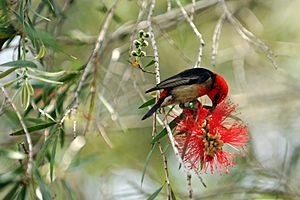Scarlet myzomela facts for kids
Quick facts for kids Scarlet myzomela |
|
|---|---|
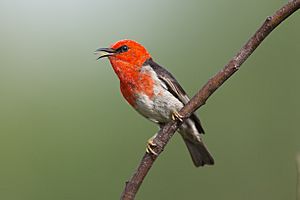 |
|
| Male | |
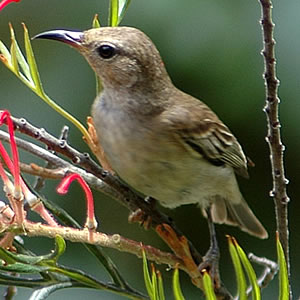 |
|
| Female | |
| Conservation status | |
| Scientific classification | |
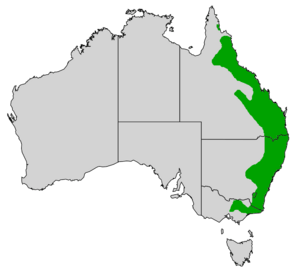 |
|
| Scarlet myzomela natural range |
The scarlet myzomela or scarlet honeyeater (Myzomela sanguinolenta) is a small passerine bird. It belongs to the honeyeater family, called Meliphagidae. This bird is native to Australia. An English bird expert, John Latham, first described it in 1801.
The scarlet myzomela is the smallest honeyeater in Australia. It is about 9 to 11 centimetres (3.5 to 4.3 in) long. It has a short tail and a bill that curves downwards. Males and females look different. The male is a bright red with black wings. The female is all brown. This bird makes more sounds than most honeyeaters. It has many calls, including a sound like a bell.
You can find the scarlet myzomela along most of Australia's eastern coast. This goes from Cape York in the north to Gippsland in Victoria. In the southern areas, these birds move north for winter. They live in forests and usually look for food in the tops of trees. They eat both insects and nectar from flowers. A pair might raise up to three groups of young in one breeding season. The female lays two or three white eggs with speckles. The nest is cup-shaped and about 5 centimetres (2 in) wide, built high in a tree. The IUCN says this bird is of least concern. This means its population is stable and not in danger.
Contents
About the Scarlet Myzomela
The scarlet myzomela is also known as the scarlet honeyeater in Australia. Scientists often use its official name, scarlet myzomela. In the past, people called it the "sanguineous honeyeater." Other old names include "soldier-bird" because the male looks like he wears a red coat, and "blood-bird."
Scientists study the DNA of birds to understand how they are related. Studies show that the scarlet myzomela is closely related to the cardinal myzomela. They are also related to other birds like pardalotes and fairy-wrens.
What Does the Scarlet Myzomela Look Like?
This bird is the smallest honeyeater in Australia. It has a small body, a short tail, and a black bill that curves down. Its eyes are dark brown. It is about 9 and 11 centimetres (3.5 and 4.3 in) long. Its wings usually spread about 18 centimetres (7.1 in) wide. It weighs about 8 grams (0.28 oz).
Males and females look very different. This is called sexual dimorphism.
- The adult male has a bright red head, neck, and upper chest. He has a thin black line from his beak to his eye. His back and rump also have a red stripe. His wings are dull black, and his tail is black.
- The female has a brown head and neck. Her throat and chin are light grey-brown. Sometimes, she has pink or reddish spots on her face. Her upper body is brown. Her tail is brownish-black.
Young birds look like females but have more reddish-brown on their upper parts. Young males get patches of red feathers as they grow. Both males and females get their adult colors after two molts (when they shed old feathers and grow new ones).
Sounds and Calls
The scarlet myzomela is often heard before it is seen. It has many different calls. The male sings more than the female. Its main call is a pretty, tinkling sound. It has sets of six notes that go up or down in tone. Some people say it sounds like rubbing a cork on glass.
The female makes chirping sounds when she hops around or meets the male. She can also make a squeaking sound. Both male and female birds make a short chiew-chiew call to stay in touch with each other.
Where Do Scarlet Myzomelas Live?
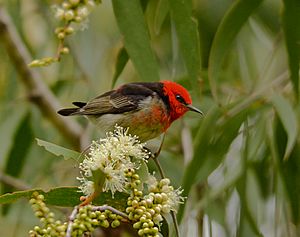
You can find the scarlet myzomela along the eastern coast of Australia. This area stretches from Cooktown in northern Queensland down to Mitchell River National Park in Gippsland, Victoria. They are less common south of the Hacking River in New South Wales. Their range goes inland to places like Charters Towers in Queensland.
These birds move around a lot. In the southern parts of their range, they are migratory. This means they move north for the winter. In the north, they tend to stay in one place. Sometimes, they move to new areas when their favorite food plants are flowering.
The scarlet myzomela lives in dry sclerophyll forests and woodlands. These areas usually have eucalypt trees and not much undergrowth. You might see them alone, in pairs, or in small groups. They sometimes join other honeyeaters in the tops of flowering trees.
How Scarlet Myzomelas Behave
The scarlet myzomela is a territorial bird. Males sing from the tops of trees to show where their territory is. They compete with other scarlet myzomelas. Larger honeyeaters, like Lewin's honeyeaters, often chase them away from feeding spots.
Reproduction and Life Cycle
Scarlet myzomelas breed from winter through summer, usually starting around July or August and ending in January. A pair often raises one or two groups of young each year. If a nest fails, they might try for a third group. Females can lay eggs about three weeks after their previous young have left the nest.
The nest is a small cup made of shredded bark and spider webs. It is built high up in the tree canopy or even in mistletoe. They often choose trees with thick leaves, like lillypilly or eucalypts.
The nest is about 5 cm (2.0 in) wide. It takes about 8 days to build before the eggs are laid. Both parents help build the nest. The small eggs are white with reddish-brown or grey-purple speckles. Eggs are laid one day apart. The female usually incubates (sits on) the eggs by herself. The young birds are born without feathers but soon grow soft down. They stay in the nest for 11–12 days before they are ready to fly. Both parents feed their young.
Feeding Habits
The scarlet myzomela lives in trees and looks for food in the treetops. It flies from flower to flower, using its long, curved bill to find nectar. Sometimes, it hovers in front of flowers while it eats. It visits trees like turpentine, paperbarks, and banksias.
The scarlet myzomela is an omnivore. This means it eats both plants and animals. Besides nectar, it also eats insects. It catches flying insects in the tree canopy. The insects it eats include beetles, flies, and caterpillars.
Conservation Status
The IUCN lists the scarlet myzomela as a species of least concern. This means it is not currently in danger of disappearing. It has a very large range, covering about 1,960,000 square kilometers. Its population seems stable, with no signs of a big decline.
Images for kids
-
Turpentine (Syncarpia glomulifera), a commonly-foraged tree
See also
 In Spanish: Mielero escarlata para niños
In Spanish: Mielero escarlata para niños



